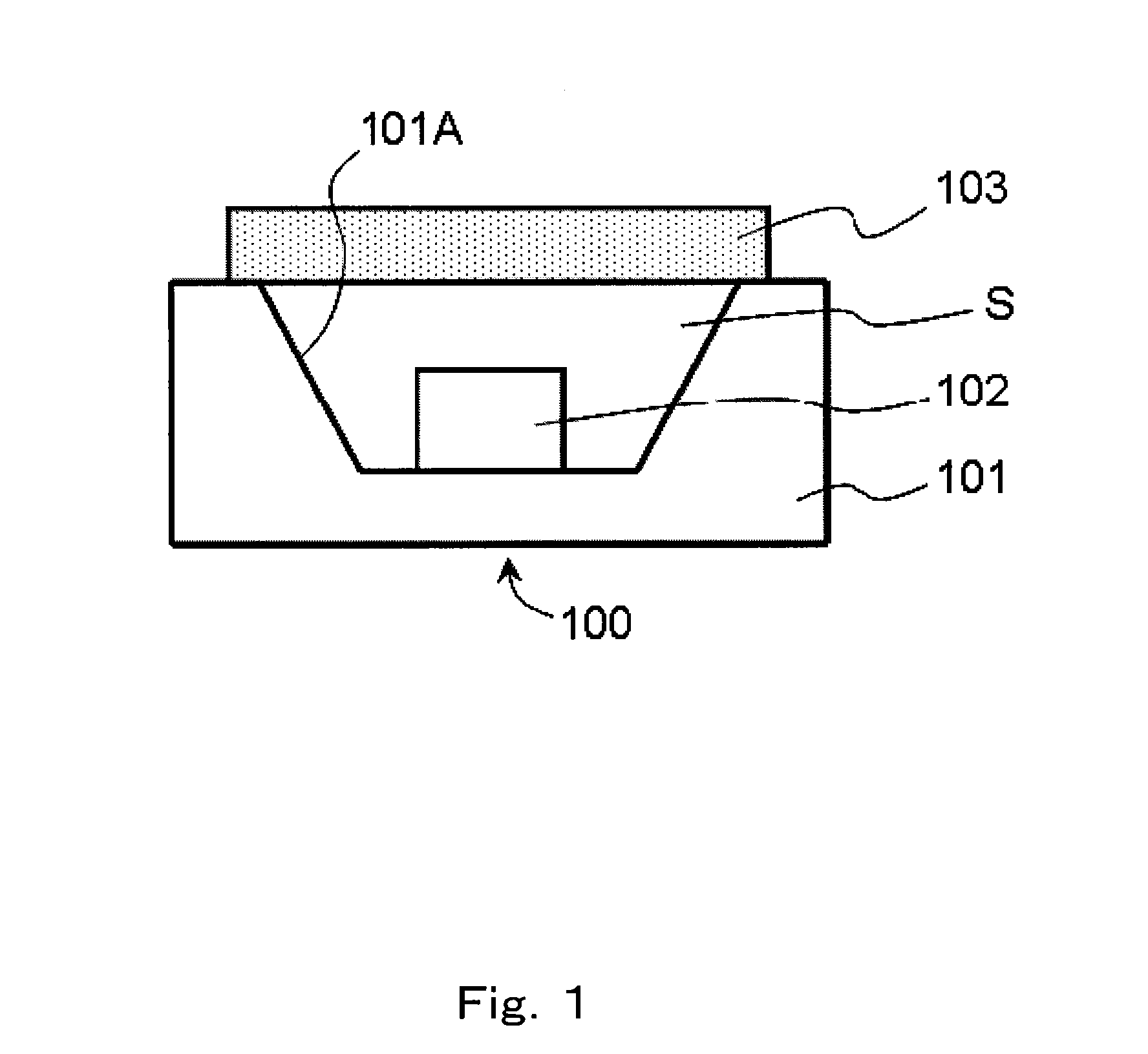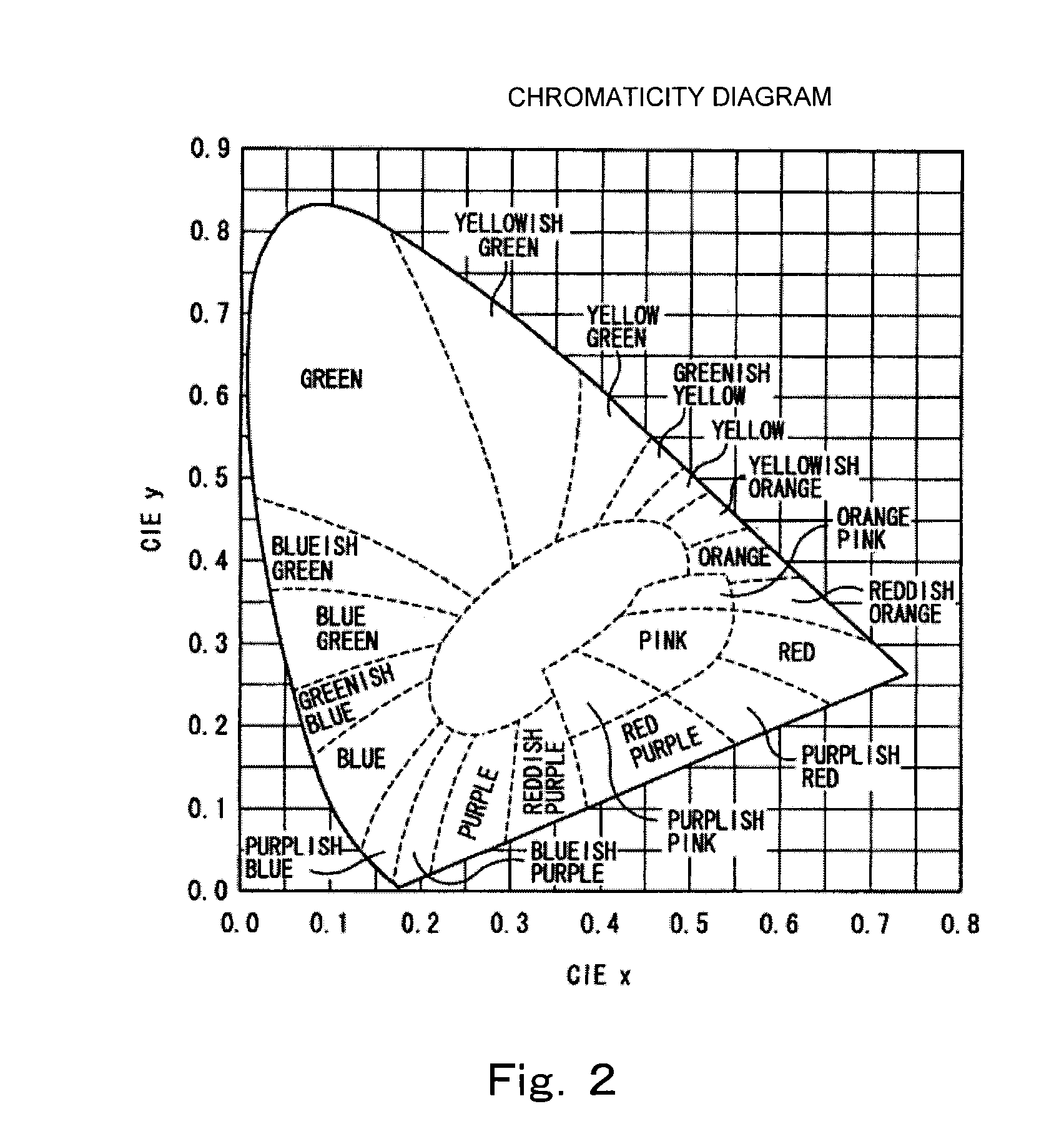White semiconductor light emitting device
a technology of light-emitting devices and semiconductors, which is applied in the direction of discharge tube luminescnet screens, energy-saving lighting, sustainable buildings, etc., can solve the problems of difficult to reproduce the high r9 values of white leds, and achieve excellent durability and heat resistance, high degree of covalency, and high luminous efficiency
- Summary
- Abstract
- Description
- Claims
- Application Information
AI Technical Summary
Benefits of technology
Problems solved by technology
Method used
Image
Examples
example 1
[1] Example 1
[0089]FIG. 1 is a cross-sectional diagram illustrating the structure of a white light-emitting semiconductor device 100 according to example 1. The white light-emitting semiconductor device 100 comprises an SMD-type package 101, a light-emitting semiconductor element 102 and a wavelength conversion part 103. The light-emitting semiconductor element 102 is a blue light-emitting element having an emission peak wavelength lying within the range from 430 to 470 nm, preferably from 440 to 460 nm. The wavelength conversion part 103 includes a wide-band red phosphor and a green phosphor (phosphors not illustrated in the figure) that emit light upon being excited by the light-emitting semiconductor element 102. The term “green phosphor” means a phosphor which emits light having a color that is classified as “GREEN” or “YELLOWISH GREEN” in the xy chromaticity diagram (CIE 1931) shown in FIG. 2. The term “red phosphor” in the invention means a phosphor which emits light having a ...
example 2
[2] Example 2
[0105]The white light-emitting semiconductor device according to example 2 differs significantly from the white light-emitting semiconductor device of example 1 as regards two features. Firstly, a purple light-emitting element having a emission peak wavelength ranging from 400 to 430 nm, or an ultraviolet light-emitting element having an emission peak wavelength shorter than 400 nm (ordinarily, 360 nm or longer) is used instead of the blue light-emitting element, as the light-emitting semiconductor element. Secondly, the wavelength conversion part includes a blue phosphor.
[0106]The term “blue phosphor” means a phosphor which emits light having a color that is classified as “PURPULISH BLUE”, “BLUE”, or “GREENISH BLUE” in the xy chromaticity diagram (CIE 1931) shown in FIG. 2.
[0107]The light-emitting semiconductor element used in the white light-emitting semiconductor device according to the example 2 is preferably a purple light-emitting element, on account of the smalle...
example 3
[4] Example 3
[0126]An example is explained next in which the present invention is used in a light-emitting module for tunable illumination.
[0127]FIG. 3 is a perspective-view diagram of a white LED 8 that is mounted on a light-emitting module 30 for illumination (see FIG. 7 described below). FIG. 4 is a plan-view diagram illustrating the way in which LED chips 3A, 3B are connected to lead electrodes 20A, 20B in the white LED 8 illustrated in FIG. 3. FIG. 5 is a diagram illustrating a circuit configuration of the white LED 8 illustrated in FIG. 3 and FIG. 4. FIG. 6 is a cross-sectional diagram of the white LED 8 illustrated in FIG. 3 and FIG. 4, cut along a plane that includes the lead electrodes 20A, 20B.
[0128]As shown in FIG. 3, the white LED 8 comprises a package 1 that has two cups. The package 1 has an insulating substrate 2, lead electrodes 20A, 20B (not shown in FIG. 3) patterned on the surface of the insulating substrate 2, a ring-like frame 10 joined to the top of the insulat...
PUM
 Login to View More
Login to View More Abstract
Description
Claims
Application Information
 Login to View More
Login to View More - R&D
- Intellectual Property
- Life Sciences
- Materials
- Tech Scout
- Unparalleled Data Quality
- Higher Quality Content
- 60% Fewer Hallucinations
Browse by: Latest US Patents, China's latest patents, Technical Efficacy Thesaurus, Application Domain, Technology Topic, Popular Technical Reports.
© 2025 PatSnap. All rights reserved.Legal|Privacy policy|Modern Slavery Act Transparency Statement|Sitemap|About US| Contact US: help@patsnap.com



